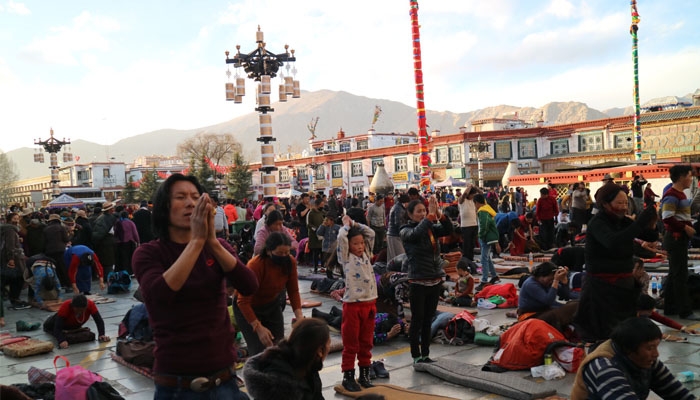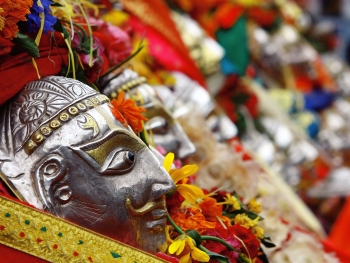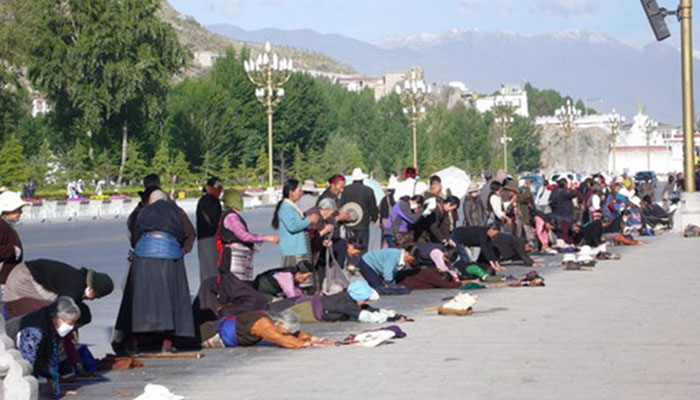When is Saga Dawa Festival: Significance, Celebrattion, Places to Visit and Why "The Poor’s Day'
 |
| When Is Saga Dawa - Traditional Tibetan Buddhist Festival? Photo Tibettour |
Tibetans consider the Saga Dawa festival to be one of the most auspicious religious practice in their life. In Tibetan “Saga” is the name of a star most visible during the fourth lunar month of the Tibetan calendar and “Dawa” means month.
When is Saga Dawa Festival?
Saga Dawa is celebrated on April 15 in Tibetan calendar. The Saga Dawa Festival will be celebrated on 26 May 2021 in solar calendar.
In Tibetan, Saga means “fourth”, while Dawa translates to “month”, hence the time of the festival and the name. While the festival’s main event is on the 15th day, the celebrations last for the whole of the fourth month, making it one of the longest of the Tibetan festivals. The date does vary, though, due to the difference of the Tibetan lunisolar calendar with the Gregorian calendar. It is normally held sometime in May or June in the solar calendar.
 |
| Photo Tibettour |
The festival is one month long, starting from the new moon of the fourth month, and ending with the full moon of the next month. In Gregorian calendar it usually falls on May – June.
The full moon day or 15th day of the month is called Saga Dawa Duchen. It is the most special day of the month. In Tibetan “Dunchen” means great occasion. It is the most important day in Tibetan Buddhism.
Saga Dawa Festival is also called “the Poor’s Day”
While the festival celebrates the major events in the life of Buddha, it is also known for being a day when people give more generously to the poor. In Chinese, the festival is called “Qiong ren jie”, which translates to Poor People’s Day, and in Tibet, people practice giving to the monks and nuns and the poor of the community. Tibetans believe that giving to the poor accumulates merits, and more so in the month of Saga Dawa. |
Saga Dawa Festival : Significance
The Vesak takes place during the 3 full moon days of the 4th month. The Vesak’s origin is India, it is a word that comes from the Sanskrit “Vaishaka”, which means the month of April / May, the month of the harvest.
A little like Pentecost came to settle on the harvest festivals in many Western countries, Vesak was originally the Harvest Festival in the state of Punjab, which is the rice granary of India .
And then, Buddhism gave it a new meaning, that of birth, then illumination of wakening (Boddhi), then finally the perfect extinction (parinirvana) of the historical Buddha (Sakyamuni).
We have gradually desired the three together, perhaps to save a little bit the public holidays, especially in the countries of Theravada or Hinayana, the Small Vehicle (Southeast Asia).
In the countries of the Great Vehicle (Tibet, Kham, Amdo among others), we have often kept separate the festivals, at eight days apart.
The birth of Sakyamuni, the 8th day of the lunar month, remains a moment of celebration except for Tibetans.
Similarly, the awakening and death of Sakyamuni Buddha are celebrated on the 15th day of the 4th month.
**READ MORE: Telangana Formation Day (June 2): History, Significance, Celebrations in India
Saga Dawa Festival: Celebrations
This day during Saga Dawa Festival worships the life of Buddha and coincides with three main events in his life:
1. The Birth of Buddha
According to the scriptures, the date of Buddha’s birth is different from the conventional viewpoint. It is not the date when he was born, but the day when he entered the womb of his mother. In other words, it is the day of his conception. According to the Buddhist philosophy, the first moment of the consciousness with the contact of parent’s cells in the womb of the mother is considered to be an actual birth. It is the very beginning of life or rebirth. That’s why the moment when historical Buddha entered the womb of queen Mahayana of the Shakya Royal family on the full moon day of the Vesak month is regarded as Buddha Shakyamuni’s birth.
2. Buddha’s Enlightenment
At the age of 35 Buddha presented his attainment of enlightenment under the Bodhi tree in Bodhgaya. The earth trembled at that moment as he touched it. That’s why you can see Shakyamuni Buddha with a touching earth gesture on sculptures and paintings.
3. Buddha’s Parinirvana (death)
At the age of 80 historical Buddha performed his last deeds and entered into Parinirvana in Kushinagar.
Tibetans strongly believe that all good deeds help accumulate good karma. You will carry it for your next life and all virtues acts will help with a favorable rebirth. They also believe that the merit of worthy acts is multiplied during the holy festival.
That’s why Tibetans dedicate the entire month to making merit. The fifteen day is one of the most sacred days to earn good merit. According to Buddhism, all good deeds during that time are multiplied 100,000 times.
Pilgrims from all over Tibet visit the most sacred sites. The most important and popular places are Lhasa and Mount Kailash, one of the most sacred places in Tibet. The atmosphere in the holy places is festive and spiritual. It makes it one of the best times to visit for tourists.
One of the best places to visit during Saga Dawa is Mount Kailash. It attracts thousands of pilgrims. A new flagpole is erected every year at the base of the mountain. It is a great time to travel to Mount Kailash and join pilgrims walking the kora, a holy circumambulation around the Mountain.
Activities to do on Saga Dawa Festival
VISITING MONASTERIES
During the Saga Dawa, people visit monasteries, temples, stupas, as well as holy mountains, lakes, caves and other sacred places. Pilgrims offer butter lamps, burn incense, pray and recite mantras. Some perform whole body prostrations.
 |
| Photo Wondersoftibet |
In Lhasa you can see many Tibetans visiting Jokhang temple, Potala Palace and walking around the Lingkhor path. Lingkor is the first City ring, about 10 km long.
OFFERING DONATIONS
The generosity (Dana), act of giving is very important during the holy month. Tibetans make donations to poor people, monasteries and temples.
REFRAIN FROM EATING MEAT
Tibetans not only stop eating meat, but also try to save animal lives by buying and freeing animals from slaughter’s hands. On the fifteenth day, many people, both monastic and lay have only one meal before noon and follow the eight Mahayana precepts.
| During the festival, monks chant, read scriptures, recite mantras. Tibetans give donations to the monastery or to individual monks and nuns to recite the sacred scriptures, which helps to avoid the bad luck and bring good fortune to all the living beings. One of the most spectacular sights is the Cham Dance. During the Cham dance a group of monks dress up in religious clothes symbolizing different deities and protectors. They wear masks with different images of god and animals. During the auspicious festival, pilgrims hire a vehicle and visit venerated monasteries from all over Tibet. Many pilgrims also trek to Mount Kailash during the occasion. At the foot of the Kailash Darpuchi ceremony takes place every year on the fifteenth date of the fourth month of Lunar calendar. People gather to take down the old flagpole with hundreds of colorful prayer flags and replace it with the new one. The group of monks recite scriptures and play religious instruments. Pilgrims throw barley flour which is believed to bring luck. During the ceremony tourists from all over the world visit the sight and enjoy local events. |
PLACES TO VISIT DURING SAGA DAWA
During Saga Dawa Tibetans visit holy places. It is one of the best times in the year to see many pilgrims from all over Tibet gathering in sacred places. They wear their best costumes making the scene especially bright. The most popular places during the Saga Dawa unchen are Lhasa, Everest region, DrigungTil and Tsurpu Monasteries, and of course Mount Kailash.
Lhasa is one of the best places to visit during the festival. As a capital, it attracts many pilgrims from all over Tibet. Streets of Lhasa become crowded and you will enjoy its festive atmosphere.
| Local Tibetans will become vegetarians during the Saga Dawa Another common act in the period of the Saga Dawa is that Tibetan Buddhists will not eat meat, allowing the animals to be free and alive for their merits. The people eat only fruits and vegetables during this month, and refrain from consuming any animal products. Many will even take animals and fishes and release them back into their wild habitats to attain merits for their kindness to the creatures. These acts are all part of the ways of attaining more merits during this month of merits. |
 Shimla Summer Festival: When, Where and Activities to Celebrate Shimla Summer Festival: When, Where and Activities to Celebrate Shimla Summer Festival often starts with a huge gathering of tribal people, budding artists, and tourists to mark the advent of the summer season. This ... |
 12 Most Popular Festivals and Holidays in India During June 12 Most Popular Festivals and Holidays in India During June India is the place with plenty of festivals all over the year, and beautiful culture. Keep reading the article below for 12 Most Popular Festivals ... |
 India - Most Important Holidays and Festivals in May India - Most Important Holidays and Festivals in May India is a hierarchical society and offers astounding variety in virtually every aspect of life. Festivals of India are celebrated throughout the country with Great ... |




























